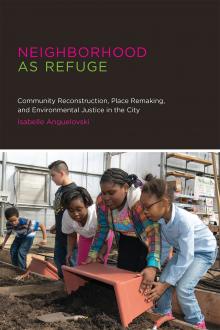Neighborhood as Refuge: Community Reconstruction, Place Remaking, and Environmental Justice in the City

In Neighborhood as Refuge, Isabelle Anguelovski challenges conventional wisdom in the field of urban environmental justice by arguing for a renewed focus on the roles of place, community, and a sense of wellbeing in how urban neighbourhoods rebuild after environmental trauma. Through a comparative analysis of three marginalized urban communities –Casc Antic in Barcelona, Dudley in Boston, and Cayo Hueso in Havana– Anguelovski describes how environmental justice activists used physical, environmental, and health improvements to reshape their relationship with their place and their relationships with the political institutions, processes, and actors that affect it. The core argument of the book is that, through actively mobilizing for local-level improvements, neighbourhood residents, activists, and allies are able to strive for more robust and resilient outcomes in the face of entrenched spatial and socioeconomic injustices.
The book contains a historical narrative of how the three neighbourhoods in Barcelona, Boston, and Havana have regenerated after decades of social and environmental trauma. In particular, Anguelovski narrows in on the specific tactics and strategies that neighbourhood residents, activists, and allies have employed to reconstruct a broad sense of place. These strategies include advocating for access to healthy food, urban gardens, playgrounds for children, and other seemingly minor community-level quality of life improvements. However, these incremental and place-based mobilizations are specifically designed to help residents achieve environmental recovery and rootedness, create safe havens, celebrate the community, and, eventually, develop a stronger collective identity. For Anguelovski, a strong place-based attachment to environmental revitalization projects is predicated on the ability of residents to form a closely knit village, celebrate the diversity and history of the community, enhance mutual learning and coexistence, and recreate a strong and affirmative local collective identity beyond a past of urban decay and abandonment.
Through globally comparative yet empirically nuanced accounts of neighbourhood reconstruction and revitalization, Anguelovski advocates for a renewed focus on community health and place-based activism as a barometer for gauging urban environmental improvements and spatial justice. The book shows that similar tactical choices and strategies for advocacy emerge regardless of the radically different politics found across Boston, Barcelona, and Havana. In fact, the tactics of building large coalitions and tight bottom-to-bottom networks emerge from collective experiences of marginalization, abandonment, and exasperation common to the three neighbourhoods. These experiences compel residents to rebuild communities from the ground up by delineating safe spaces, rekindling social and kinship networks, and striving for healthy food, housing, and recreation.
The book’s contribution is its argument for how place, place attachment, and sense of community shape struggles for long-term environmental quality and livability in urban deprived neighborhoods. The projects that it describes succeeded because different urban actors came together to improve the environmental quality and livability of their neighbourhoods through projects that transformed environmental conditions, rebuilt broken communities, and remade place for residents. The book concludes by calling for a reexamination of the broader urban political economy of environmental inequality production, which is necessary in order to sustain community rebuilding and place remaking successes over time.
Book note prepared by Eric Chu
Search the Book notes database
Our Book notes database contains details and summaries of all the publications included in Book notes since 1993 - with details on how to obtain/download.
Use the search form above, or visit the Book notes landing page for more options and latest content.
For a searchable database for papers in Environment and Urbanization, go to http://eau.sagepub.com/

